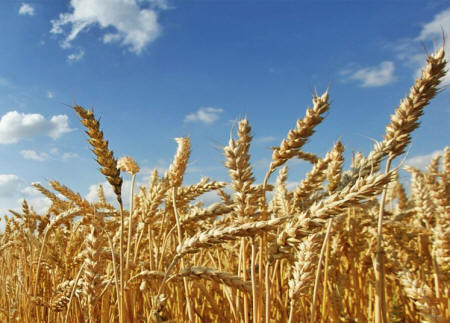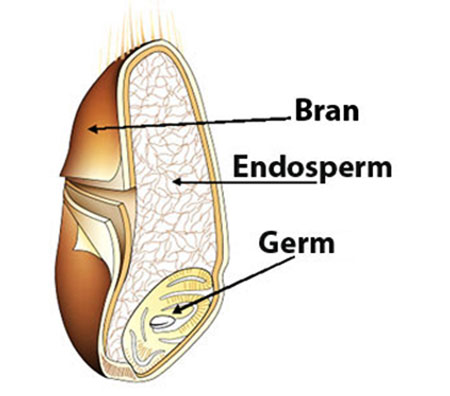|

by Catherine J. Frompovich
October 26, 2015
from
NaturalBlaze Website

Wheat, which used to be considered a "staff of life," in recent
times, has become a dietary scourge for numerous men, women, and
children. What happened, especially when there are so many processed
foods that contain wheat or wheat derivatives?
First and foremost, we ought to realize that wheat grown today is a
hybridized version of heirloom wheat during the early 20th century.
Einkorn, [1] which probably was the oldest variety of wheat known
and grown for thousands of years, has fallen out of favor even
though it contains a lower percentage of gluten.
According to
Tropical Traditions' article, "Einkorn
Ancient Grain,"
Since einkorn is such an ancient grain and the only known diploid
classified variety of wheat still known to exist today, there has
been considerable interest in the issue of gluten toxicity.
One way
of measuring gluten toxicity is by the
gliadin to
glutenin ratio,
and einkorn has a much more favorable ratio than modern wheat
varieties.
Einkorn has a gliadin to glutenin ratio of 2:1 compared
to 0.8:1 for durum and hard red wheat.
While this lower gluten ratio
may hold some promise for gluten intolerance disorders, it should be
cautioned that einkorn DOES contain gluten, and so those desiring to
avoid all gluten are NOT recommended to consume einkorn. [1]
Gliadin is another classification of proteins in grains, e.g.,
wheat, whereas glutenin is the major protein in wheat (47%).
Gluten
is an elastic-like protein remaining after the starches are washed
away. Numerous vegetarian "meats" are made with "Seitan". [2]
As Tropical Traditions explains,
"Einkorn has a gliadin to glutenin
ratio of 2:1 compared to 0.8:1 for durum and hard red wheat.
Old
Ways Whole Grains Council says, [3]

Different types of wheat have
different numbers of chromosomes, and some studies show that the
older wheats, with fewer chromosomes, tend to have lower levels
of gliadins, the type of gluten proteins that seem to cause most
sensitivities.
Einkorn, the oldest known type of
wheat in our current food supply, has just 14 chromosomes, and
is called a diploid wheat. Durum wheat (the kind most often used
for pasta) and emmer are tetraploid wheats, with 28 chromosomes.
Common wheat (used for most everything) and spelt have 42
chromosomes and are known as hexaploid wheats.
Research shows that different tetraploid and hexaploid wheat
varieties differ widely
in gliadin levels, and
it's possible to select "individual
genotypes with less Celiac Disease-immunogenic potential."
Some heirloom wheat varieties grew very
tall and were not manageable for industrial farming practices, so
newer varieties were developed in the 1950s and 1960s by
Norman
Borlaug, father of the Green Revolution.
He [Borlaug] pioneered new
"improved" species of semi-dwarf wheat that, together with
complimenting fertilizers and pesticides, increased yield
spectacularly.
This amazing new farming technology was
propagated around the world by companies like
Dupont and
Monsanto, while mid-20th-century humanity applauded
the end of
hunger. [4]
Furthermore,
So let's reject the profound genetic
changes in modern wheat, in favor of traditional species our
bodies recognize. Let's reject the chemical fertilizers,
herbicides, fungicides and pesticides of modern industrial
farming in favor of organic farming and clean seed. [5]
That's only half of the story regarding
what's happened to wheat!
So, what else goes on with wheat?
Shortly before harvesting wheat - about 3
days, farmers routinely spray the crop
with Roundup® [5] since glyphosate
- its main component - is considered to be a desiccant that
enables a more evenly ripened crop harvest, plus less work for
farmers, or so it's been said.
Not only is wheat sprayed with Roundup®
pre-harvest, so are the following crops:
Oats, non-GMO canola, flax,
peas, lentils, non-GMO soybeans, dry beans and sugar cane!
So, it's
most important to buy, cook, and eat organically-grown grains, beans
and lentils (legumes).
Even if the crops are not GMO, they
still can be sprayed with Roundup®! Glyphosate, the main active
ingredient, has been
declared a Class 2B carcinogen by the World
Health Organization's IARC. [6]
Wheat, when stored in grain silos, can
be fumigated with toxins such as phosphine, chloropicrin, and methyl
bromide.
According to the University of
Minnesota/Extension,
So fumigants are able to penetrate
into places that are inaccessible to insecticide sprays or
dusts.
All fumigants are poisons-highly
toxic to humans and other warm-blooded animals, as well as to
insects. Consequently, they are classified as Restricted Use
Pesticides and in accordance with Minnesota State Pesticide Law
can be applied only by certified and licensed fumigators.
[7]
When wheat grain is milled into flour,
there are other processes that further compromise the resulting
flour, e.g., milling, removal of bran, fiber and germ, to leave a
powder-like substance, the endosperm, which becomes flour, that is
bleached and 'enriched' with added synthetic B vitamins and iron.

But that's not where
wheat's tragic
flour story ends.
The chemical
Azodicarbonamide
(ADA) [8] is added as a dough conditioner when
wheat flour is made into various food products like breads,
pastries, etc. As a matter of fact, there are close to 500 food
items that contain ADA.
According to Dr. Edward F Group, DC, ND,
founder of Global Healing Center, ADA can cause the following
adverse health effects:
Personally, I imagine that it would
negatively affect the gut microbiome and even cause digestive
problems, e.g., heartburn.
Additionally, ADA increases the gluten
content in bread! That's not what we need, especially with all the
gut problems and gluten sensitivities occurring in so many folks
recently.
Furthermore, ADA is banned in Europe and
Australia! U.S. FDA and USDA, what gives with you, anyway? Why
aren't you banning ADA in the USA? Additionally, ADA is an
industrial chemical used in the manufacture of yoga mats, shoe
rubber and synthetic leather!
Mmm, mmm, good...!
To top off the above, ADA creates toxic
byproducts when heated:
Semicarbazide causes free radical damage
to DNA [9] and damages human immune cells and DNA of animals.
[10]
So, what's it doing in USA-made wheat products?
Would readers like to know which brands
and products contain Azodicarbonamide? Well,
here's the list. Data provided by FoodEssentials as of
2/27/2014.
Wheat is just one example of how a
natural food crop, which humans subsisted on for millennia, has been
bastardized by modern chemistry and farming practices into becoming
a bane to eaters.
The only way consumers can get relief is
to:
-
Purchase and eat only
organically-grown foodstuffs.
-
Boycott food purveyors who do
not meet healthful standards and practices for the products
they produce and sell.
-
Complain in writing to federal
and state agencies about toxins in the food supply.
-
Support those who are taking
steps to clean up the toxic mess food has become.
Bon
appétit...!
References
[1]
http://www.tropicaltraditions.com/einkorn-ancient-grains.htm
[2]
https://www.google.com/search?q=vegetarian+meats+made+from+...
[3]
http://wholegrainscouncil.org/newsroom/blog/2012/01/research-sheds-light-on-gluten-issues
[4]
http://www.grainstorm.com/pages/modern-wheat
[5]
http://naturalsociety.com/which-of-your-foods-are-sprayed-with-round-up-just-3-days-before-harvest/
[6]
http://www.scientificamerican.com/article/widely-used-herbicide-linked-to-cancer/
[7]
http://www.extension.umn.edu/agriculture/small-grains/harvest/fumigating-stored-grain/
[8]
http://wakeup-world.com/2014/03/04/what-is-azodicarbonamide-9-facts-about-this-dangerous-food-additive/
[9] Hirakawa K, Midorikawa K, Oikawa S, Kawanishi S.
Carcinogenic semicarbazide induces sequence-specific DNA damage
through the generation of reactive oxygen species and the
derived organic radicals. Mutat Res. 2003 Apr
20;536(1-2):91-101
[10] Vlastos D, Moshou H, Epeoglou K.
Evaluation of genotoxic effects of semicarbazide on cultured
human lymphocytes and rat bone marrow. Food Chem Toxicol.
2010 Jan;48(1):209-14. doi: 10.1016/j.fct.2009.10.002. Epub 2009
Oct 9.
|




